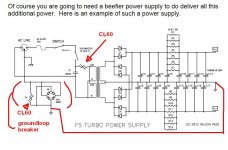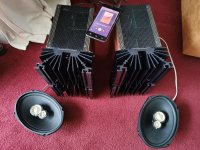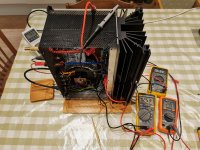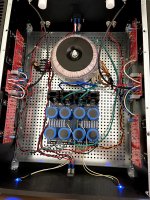to Phoenix NJ ##6518/6519
Hello Phoenix NJ,
what I see on the pics -and how the FE-board is stuffed- you have a F5 Turbo V2.
One pair of JFets and no cascoding.
You could tell us how high your railvoltages out of the PSU are? I think +-32V.
In the pic below is a description of 6L6 how to adjust the F5t for start up.
I made some additions.
It would be very wise to have a dim- bulb-tester.
Greets
Dirk 😀
Hello Phoenix NJ,
what I see on the pics -and how the FE-board is stuffed- you have a F5 Turbo V2.
One pair of JFets and no cascoding.
You could tell us how high your railvoltages out of the PSU are? I think +-32V.
In the pic below is a description of 6L6 how to adjust the F5t for start up.
I made some additions.
It would be very wise to have a dim- bulb-tester.
Greets
Dirk 😀
Attachments
I did a little poking around but didn't find a Power supply thread that discusses the cl in so far as it directly relates to this kind of supply. I found some peripheral info. If you know of a link that runs in this vein could you post a link?
I have this sorted well enough for the build. I'd just like to learn the whys
I have this sorted well enough for the build. I'd just like to learn the whys
to Phoenix NJ6522
Hello Phoenix NJ,
a pic of the F5T-power supply by Nelson Pass and a link to his article about all kind of F5Ts.
If you build a F5T - read this first! 😉
https://www.firstwatt.com/pdf/art_f5_turbo.pdf
Cheers
Dirk 😀
Hello Phoenix NJ,
a pic of the F5T-power supply by Nelson Pass and a link to his article about all kind of F5Ts.
If you build a F5T - read this first! 😉
https://www.firstwatt.com/pdf/art_f5_turbo.pdf
Cheers
Dirk 😀
Attachments
Thanks for the advice. I've tried a DC bolcker with no audible effect on the mechanical transformer hum. It was a design from Rod Elliott site. It seemed easier to make his recommended design than try measure the mains DC (I had the parts). I've built mono blocks and have a 500VA transformer for each channel. I'd be supprise if they were both defective, but not supprised if they weren't designed to be quiet at 240V.
That transformer fits very well inside a completely standard bathroom trash bin. Mine will go there ASAP once my Toroidys are installed.
Come to think of it, I might let my kids work on their hammering skills on it. I think I gave you a similar advice during the winter months.
You could try umbilicals and put it under your neighbours pillow. That might silence it, to your ears at least.

But seriously: That piece of Swedish junk is not worthy of a place inside your wonderfully built amp, Shteve. IMO.
Regards,
Andy
Last edited:
Transformer rating
Ok, at the risk of triggering the 'not again' claxon, I'd like some opinions as to using a transformer with 20V 5A secondarys for my F5T monoblocks? They are currently using Noratel 25V 10A secondary transformers biased to 250mV across source resistors creating max heatsink temperature of ~41C in 20C ambient. Each monoblock is drawing 66.6W from the wall measured using a cheap plug type meter. They sound great! Except for the mechanical hum of the transformers. I've tried lots of 'fixes' that have massively reduced the mechanical hum, but I want the quieter. Advice has been 'go for better quality transformer'
I have read that transformer VA rating should be 2.5 to 3 x power requirement of the amplifier. At the existing bias and 66.6W, a 200VA transformer would be 3 times and safe. I could go up to 80W by increasing the bias and still be safe at the 2.5 x requirement. I'm not sure if the 2.5 to 3 x power requirement includes the inefficiencies or not, or if I've understood any of it correctly. What do you think?
I do realize that the (excellent) build guide suggests min 600VA for a stereo amp and I'm presuming that means 300VA is ok for monoblock. But my heat sinks are smaller and I'm happy with the sound as it is. And I've also read 300VA is where one should expect to hear mechanical hum. I've found some NOS transformers that are of higher quality than I was expecting to afford and would like to use them if I can, safely.
Hope you are all having fun!
Steve
Ok, at the risk of triggering the 'not again' claxon, I'd like some opinions as to using a transformer with 20V 5A secondarys for my F5T monoblocks? They are currently using Noratel 25V 10A secondary transformers biased to 250mV across source resistors creating max heatsink temperature of ~41C in 20C ambient. Each monoblock is drawing 66.6W from the wall measured using a cheap plug type meter. They sound great! Except for the mechanical hum of the transformers. I've tried lots of 'fixes' that have massively reduced the mechanical hum, but I want the quieter. Advice has been 'go for better quality transformer'
I have read that transformer VA rating should be 2.5 to 3 x power requirement of the amplifier. At the existing bias and 66.6W, a 200VA transformer would be 3 times and safe. I could go up to 80W by increasing the bias and still be safe at the 2.5 x requirement. I'm not sure if the 2.5 to 3 x power requirement includes the inefficiencies or not, or if I've understood any of it correctly. What do you think?
I do realize that the (excellent) build guide suggests min 600VA for a stereo amp and I'm presuming that means 300VA is ok for monoblock. But my heat sinks are smaller and I'm happy with the sound as it is. And I've also read 300VA is where one should expect to hear mechanical hum. I've found some NOS transformers that are of higher quality than I was expecting to afford and would like to use them if I can, safely.
Hope you are all having fun!
Steve
I’d consider that only if your speaker’s don’t need the extra wattage. Your F5T will be able to run at a higher bias with lower voltage, and that is a plus. But the limitation of bias current lies in the diodes. Iow, if you are maxing bias now, lower voltage rails means lower wattage but no more bias current. Though the temp at the same bias will be lower, also affecting diode conductance (reducing it). Perhaps worth trying, but it will take some of the T out of the amp. I am infact doing the same with my BA-3, iot increase bias. But that amp does not have diodes in parallell with it’s output transistors.
Why not contact Hubert over at Toroidy in Poland? Custom built stuff for the price of a few hours overtime.
IME large toroids seem more likely to buzz than smaller ones. My F5V3 monos hav 800va toroids and one hums more than the other. I had to get a replacement for one of them it was just too loud at the listening chair.
I have problems here with DC offset on the line as well as a higher than nominal 124 volts ac in the summer months. I built and installed a 40 amp line filter and dc blocker to plug the amps into and that helped.
Right now the buzz is not audible at the listening chair.
If doing it again for each monoblock I would use 2 of the Antek 400va transformers that I used in my Aleph J build. In the Aleph, using one transformer it is nearly silent and I am also running it hard at about 250va draw. That transformer is actually the 2x 20v version that gives you about +- 25voltsDC.
Note: -Your mileage may vary. I had 3 of the 800va transformers and they all had different levels of buzz. So it is also possible that you may buy an Antek like the one in my Aleph J and it will not be as silent.
I can vouch for the quality of Toroidy transformers. They make power Toroids in 3 levels , standard, audio and a metal cased encapsulated top of the line model that I am pretty sure would be quiet. IME the audio quality ones are fine. Again YMMV.
I have problems here with DC offset on the line as well as a higher than nominal 124 volts ac in the summer months. I built and installed a 40 amp line filter and dc blocker to plug the amps into and that helped.
Right now the buzz is not audible at the listening chair.
If doing it again for each monoblock I would use 2 of the Antek 400va transformers that I used in my Aleph J build. In the Aleph, using one transformer it is nearly silent and I am also running it hard at about 250va draw. That transformer is actually the 2x 20v version that gives you about +- 25voltsDC.
Note: -Your mileage may vary. I had 3 of the 800va transformers and they all had different levels of buzz. So it is also possible that you may buy an Antek like the one in my Aleph J and it will not be as silent.
I can vouch for the quality of Toroidy transformers. They make power Toroids in 3 levels , standard, audio and a metal cased encapsulated top of the line model that I am pretty sure would be quiet. IME the audio quality ones are fine. Again YMMV.
Last edited:
If your toroid transformer is making a hum or groaning noise have you checked you AC power lines for DC riding on the lines. My house has a cyclical 25 mv of DC on the AC lines the causes even my premium transformers to groan.
Just a thought and something to check.
Just a thought and something to check.
Thanks for the feedback. I'm waiting for quotes to come back for 300VA with 24V secondaries. This seems the 'safe' thing to do.
Because I'd like to understand better, can anyone describe the calculation to define transformer VA rating if I'm biased low at 250mV due to heat sink size and max temperature restrictions. My guess is 250VA, but only because build advice is 600VA for stereo diased at 300mV.
For example, Nelson described his build of the F5V1 as being biased low at 1 amp per channel (250mV per output divice?) He found the sound more authoritive and relaxing than the original F5, good enough for me! Would this be achievable with 500VA transformer for stereo, or have I misunderstood?
Because I'd like to understand better, can anyone describe the calculation to define transformer VA rating if I'm biased low at 250mV due to heat sink size and max temperature restrictions. My guess is 250VA, but only because build advice is 600VA for stereo diased at 300mV.
For example, Nelson described his build of the F5V1 as being biased low at 1 amp per channel (250mV per output divice?) He found the sound more authoritive and relaxing than the original F5, good enough for me! Would this be achievable with 500VA transformer for stereo, or have I misunderstood?
Cool!
More output devices and or more bias current = more authoritative. I believe this has most of all to do with number of devices. The T has double the amount of the vanilla F5. And with mono blocks it is quadrouple.
VA rating:
Rate it double or triple of total dissipation that the transformer will be running. If dual mono, dissipation per sink is the way to go.
For example: 250mA / 0R5 = 0A5 x 32v = 16 watts per device. X 4 = 64 watts dissipation per sink. X 3 = 192, meaning 250vA is more than enough. If not dual mono, sure a 400vA.
But, this does not take into account that diodes in parallell will put out much more current, meaning you’d perhaps be better off with 1 x 500vA or 2 x 250vA as suggested.
But you might be running V1 without diodes, sorry if I missed that.
Regards.
Andy
More output devices and or more bias current = more authoritative. I believe this has most of all to do with number of devices. The T has double the amount of the vanilla F5. And with mono blocks it is quadrouple.
VA rating:
Rate it double or triple of total dissipation that the transformer will be running. If dual mono, dissipation per sink is the way to go.
For example: 250mA / 0R5 = 0A5 x 32v = 16 watts per device. X 4 = 64 watts dissipation per sink. X 3 = 192, meaning 250vA is more than enough. If not dual mono, sure a 400vA.
But, this does not take into account that diodes in parallell will put out much more current, meaning you’d perhaps be better off with 1 x 500vA or 2 x 250vA as suggested.
But you might be running V1 without diodes, sorry if I missed that.
Regards.
Andy
Hi Andy
Thanks for the tutorial. I'm currently biasing my amps up from 250mA to 300mA to see what temperature they get to and looking forward to hearing the difference...
Have re read the NP article and see he calls for transformer to be 'at least twice the dissipation' when describing the V2 build I have. This suggests the 82W being drawn from the wall at 300mA bias and 43degree heatsink at 23 degrees ambient could be just fine with a 200VA transformer (Mono)?
Using the calculations you suggested, I could get to 0.35A bias with the same dissipation I have now (~83W) but using 20V AC secondarys. I think this would keep the heat sinks below 50 degrees, increase the bias (increasing sound quality?) with the expense of reducing max power to the speakers? I listen relatively quietly, so power doesn't ever apper limited.
Also, the IR temperate sensor I've been using says tthe transistors are the same as the heatsink. Think I need to get a thermocouple from work...
Thanks for the tutorial. I'm currently biasing my amps up from 250mA to 300mA to see what temperature they get to and looking forward to hearing the difference...
Have re read the NP article and see he calls for transformer to be 'at least twice the dissipation' when describing the V2 build I have. This suggests the 82W being drawn from the wall at 300mA bias and 43degree heatsink at 23 degrees ambient could be just fine with a 200VA transformer (Mono)?
Using the calculations you suggested, I could get to 0.35A bias with the same dissipation I have now (~83W) but using 20V AC secondarys. I think this would keep the heat sinks below 50 degrees, increase the bias (increasing sound quality?) with the expense of reducing max power to the speakers? I listen relatively quietly, so power doesn't ever apper limited.
Also, the IR temperate sensor I've been using says tthe transistors are the same as the heatsink. Think I need to get a thermocouple from work...
Last edited:
I have a 32V rail, no diode, dual pair f5 with a single 600VA transformer and 1.75A bias. It works fine, no hum.
But it used to be 24V rails, 2.5A bias which sounded better until I started listening loud.
Both of these scenarios are 50C heatsink in a single 5U chassis.
In my opinion, bias is the single most important factor...regardless of how loud you listen.
But it used to be 24V rails, 2.5A bias which sounded better until I started listening loud.
Both of these scenarios are 50C heatsink in a single 5U chassis.
In my opinion, bias is the single most important factor...regardless of how loud you listen.
Hi Hikari1, thanks for sharing your experience. It's very useful for me to read the same point made in different ways.
Having read it again, the article says I will need to keep the bias around 0.3A to keep the diods from conducting at idle. So if I want to reduce operating temperate and optimise sound quality (maxinise bias), I can reduce rail voltage at the expense of max loudness at speaker (which is not a problem to me). I feel like a slow learner, but I think I've understood the basic compromises now?
Having read it again, the article says I will need to keep the bias around 0.3A to keep the diods from conducting at idle. So if I want to reduce operating temperate and optimise sound quality (maxinise bias), I can reduce rail voltage at the expense of max loudness at speaker (which is not a problem to me). I feel like a slow learner, but I think I've understood the basic compromises now?
Shteve what’s your chassis?
It makes a gentleman sad to admit, but my heatsink are probably considered to be small. There are four 177W x 80D x 150H with the transistors attaches directly. A bit late to be changing this now. Maybe on the next one...
Err, not the source and speakers I usually use.
Attachments
Last edited:
It looks really good, Shteve. I think it is cool you made YOUR amp, nothing like it around.
Pro’s and cons about high bias is probably more complex than I could claim to understand. But I like to think of it as compromise between temp and high bias. And in a class A amplifier, high bias has some benefits. Larger class A envelope, meaning more of your watts in class A, is beneficial. Another benefit if often lower distortion, with diminishing returns being transistor specific most often.
In most amps, temp is the limit. On the F5T the diodes may or may not dictate the limit. On large enough sinks, the diodes will probably conduct before the temp get’s too high for comfort. On small sinks, one will most often reach temp max before the diodes start conducting. If I temember correctly, they start conducting around 400mA, most often a bit lower than that, and also temp dependant.
On a normal amp the consequence of too high bias will - within reason - seldom be enormous in the short term. On the T the consequence might be an explosion, and this may or may not happen very quickly. Having small sinks, this might be a risk you are in effect avoiding as temp limits you from taking the bias high enough for the diodes to go wild.
Wrt temp, you are also completely safe. Say you bias for dissipation of 16 watts per device. At 50 degrees that means a rough junction temp of approx 70 degrees celsius. Very safe. Breakdowns will be extremely seldom and probably due to quite different factors than temp.
I like your build!
Andy
Pro’s and cons about high bias is probably more complex than I could claim to understand. But I like to think of it as compromise between temp and high bias. And in a class A amplifier, high bias has some benefits. Larger class A envelope, meaning more of your watts in class A, is beneficial. Another benefit if often lower distortion, with diminishing returns being transistor specific most often.
In most amps, temp is the limit. On the F5T the diodes may or may not dictate the limit. On large enough sinks, the diodes will probably conduct before the temp get’s too high for comfort. On small sinks, one will most often reach temp max before the diodes start conducting. If I temember correctly, they start conducting around 400mA, most often a bit lower than that, and also temp dependant.
On a normal amp the consequence of too high bias will - within reason - seldom be enormous in the short term. On the T the consequence might be an explosion, and this may or may not happen very quickly. Having small sinks, this might be a risk you are in effect avoiding as temp limits you from taking the bias high enough for the diodes to go wild.
Wrt temp, you are also completely safe. Say you bias for dissipation of 16 watts per device. At 50 degrees that means a rough junction temp of approx 70 degrees celsius. Very safe. Breakdowns will be extremely seldom and probably due to quite different factors than temp.
I like your build!
Andy
Last edited:
looking for the hum
I've got a hum coming out of both speakers when the amp is turned on. The moment I turn the switch off, the hum gets quieter, then slowly goes away to nothing.
I tried moving the coax wire around, no change.
I tried moving the mains wires (IEC inlet > front switch > power supply IN), no change.
I tried wiggling some wires on the FE boards, no change.
I ran four extension cords to my neighbor's house to plug in there, hum got quite a bit worse, and was a warbling hum
I'll include a pic of the amp internals here - looking for troubleshooting steps. Thanks so much in advance!
I've got a hum coming out of both speakers when the amp is turned on. The moment I turn the switch off, the hum gets quieter, then slowly goes away to nothing.
I tried moving the coax wire around, no change.
I tried moving the mains wires (IEC inlet > front switch > power supply IN), no change.
I tried wiggling some wires on the FE boards, no change.
I ran four extension cords to my neighbor's house to plug in there, hum got quite a bit worse, and was a warbling hum
I'll include a pic of the amp internals here - looking for troubleshooting steps. Thanks so much in advance!
Attachments
Hi Hikari1, thanks for sharing your experience. It's very useful for me to read the same point made in different ways.
Having read it again, the article says I will need to keep the bias around 0.3A to keep the diods from conducting at idle. So if I want to reduce operating temperate and optimise sound quality (maxinise bias), I can reduce rail voltage at the expense of max loudness at speaker (which is not a problem to me). I feel like a slow learner, but I think I've understood the basic compromises now?
Yes, think of it as a triangle with 3 sides. One side is heat, one side bias, one side wattage (the rail voltage).
It is a balancing act between the 3. Obviously the best solution is to have big heatsinks which allows for more bias and more wattage.
Your speakers may also decide which is your priority…a 4 ohm speaker is going to want more bias than a 16 ohm speaker.
It’s all a compromise between bias, rail voltage and heatsinks but personally, having listened to an f5 with low (under 1A) bias I would say “no thanks” and just do a class a/b amp. With my speakers the f5 doesn’t start sounding good until 1.5A or so of bias.
- Home
- Amplifiers
- Pass Labs
- F5 Turbo Builders Thread




